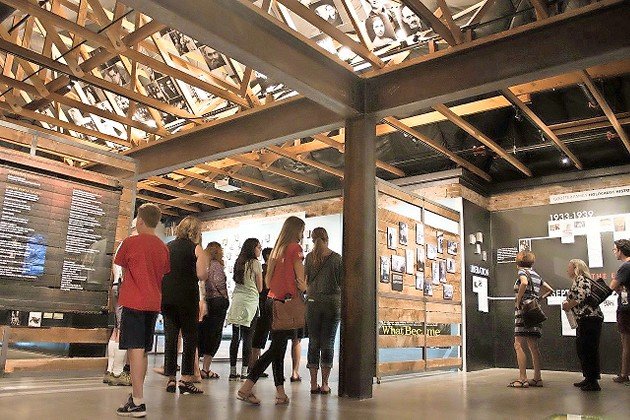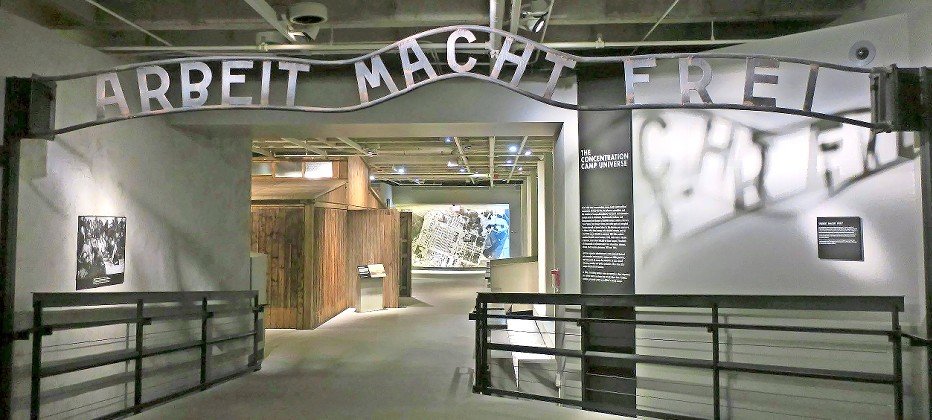Shoah museums challenged to draw non-Jews
In a study published in the Journal of Travel Research last year, scholars from the University of Illinois at Urbana-Champaign found that a visit to the Illinois Holocaust Museum & Education Center, which they dubbed “dark tourism,” made people feel empowered and inclined to identify societal concerns that need repair.
The Amercian public considers museums more trustworthy than it does researchers, scientists, NGOs, news organizations and the government, according to the American Alliance of Museums, a 117-year-old trade group representing 35,000 museums and museum professionals. But however trusted Holocaust museums are, data suggests that they have difficulty getting non-Jewish visitors through the door.
Just 26% of non-Jewish respondents told SSRS, which conducted research for the American Jewish Committee’s newly released antisemitism report, that they had ever visited a Holocaust memorial or museum.
That data is consistent with the Conference on Jewish Material Claims Against Germany’s 2018 “Holocaust Knowledge and Awareness Study,” which found that 80% of Americans had not visited a Holocaust museum. The Pew Research Center, which found in 2020 that 55% of Americans couldn’t or didn’t say that 6 million Jews were killed in the Holocaust, added that “education, visiting a Holocaust museum and knowing someone who is Jewish are strongly linked with Holocaust knowledge.”
The 27% of respondents to Pew who said they had visited a Holocaust memorial or museum answered an average of 2.9 of 4 multiple-choice questions correctly. The 73% that had not visited either a Holocaust museum or a memorial scored an average of 2 correct answers. This research comes amid charges from some critics that Holocaust museums are universalizing the Holocaust in troubling ways.
“No Holocaust museum, it seems, can be complete without invoking other 20th-century genocides in Rwanda, Darfur or Cambodia as proof that the supposed lessons of the Holocaust must be taught even more fervently than heretofore,” longtime museum reporter and critic Ed Rothstein wrote in Mosaic magazine.
“There are two problems at work in these kinds of analogies. The first is the immediate and almost reflexive urge to universalize the Holocaust so that genocide is not ‘just’ a matter of and for Jews,” wrote Rothstein. “The second is the way this ‘universalization’ takes place, reducing everything to the lowest and least significant common denominator. First come Auschwitz and Darfur, then come Auschwitz and bullying.”
Against this backdrop of universalization, JNS sought to understand how US Holocaust museums and memorials are responding to the AJC data, and what they are doing to encourage non-Jewish visitors.
Many did not respond. Others answered general questions but did not reply when JNS posed specific queries about the AJC data.
Lori Shepherd, executive director of the Tucson Jewish Museum & Holocaust Center, was an exception. “It is something that I think about every day as it relates to setting TJMHC’s programming, marketing and fundraising,” she told JNS.
The Arizona museum does not ask visitors if they are Jewish but typically learns the answer anecdotally on tours, which are all guided. “The majority of our tour visitors are not Jewish — a solid guess would be 75% to 25% — but the majority of our programming participants and donors are Jewish,” or about 65% to 35%, she said.
“One of the big reasons that our tours skew more toward non-Jews is because just over half are middle and high school-aged students on docent-led field trips,” said Shepherd, who was executive director of the El Paso Holocaust Museum for nearly five-and-a-half years. “Our numbers there were quite similar.”
When Shepherd saw the AJC report, she believed the numbers to be accurate. “Most Holocaust centers in the US are very small, and many are part of another, larger entity, so our capacity is small and our reach is localized,” she said. “This makes our ability to bring in huge numbers of Jewish or non-Jewish visitors a challenge.”
At the Tucson museum, Shepherd and colleagues try to attract broad audiences with programming. A “banned book club” will debut next month, focused on volumes that have been censored in Arizona. The club will address Art Spiegelman’s graphic novel Maus first; later selections won’t necessarily relate to the Holocaust or Judaism.
“Our most important marketing message, as Holocaust educators, is to make sure that people understand that the Holocaust is not just a Jewish story but a human story and a huge part of our collective history,” she said.
As the number of survivors dwindles, Holocaust museums that are small nonprofits will find that however little marketing experience they have and however small their budgets, those factors will “become the difference in whether we can turn this tide or not,” said Shepherd. “I believe there is always more we can do. We just need the time and resources to do it.”
Walter Reich, Yitzhak Rabin memorial professor of international affairs, ethics and human behavior and professor of psychiatry and behavioral sciences at George Washington University, is a former director (1995-98) of the United States Holocaust Memorial Museum in Washington.
AJC’s revelation that about three-quarters of Americans haven’t visited a Holocaust museum or memorial is disappointing at first glance, according to Reich.
“But one has to remember that the population of the United States stands at about 334 million, so if the AJC survey is accurate, that means that 86 million Americans have made such a visit, which I find very impressive, even if all those visits weren’t to full-fledged museums with good educational programs,” he said.
Reich thinks the AJC report’s finding that 91% of Americans believe antisemitism is a problem that affects society at large “is reassuring in this increasingly bleak time,” but he wonders about the other 9%. “Some of those 30 million Americans are, alas, antisemites,” he said. “But the rest should be reached by more Holocaust museums, as well as more Holocaust education.”
A central mission of Holocaust museums is to accurately describe what the Holocaust was to the general public, which tends to learn about it from often-inaccurate social-media posts and commercial films, according to Reich. The 1997 movie “Life Is Beautiful” was and is much beloved “because it was endearing and avoided an honest presentation of the Holocaust,” he said. “It was, as one critic correctly called it, ‘a sentimental lie.’ ”
Holocaust museums should also teach the public that the Holocaust was a product of antisemitism, which is more than 2,000 years old. “It has resulted in numerous episodes of the mass murder of Jews, wherever they have lived, during that long stretch of history — the Holocaust having been its most recent and murderous spasm,” said Reich.
Following the “bad social odor” in the few decades after the Holocaust, antisemitism “went on a kind of vacation, at least in terms of being expressed,” he continued. “But it hardly disappeared.” In recent years, antisemitism “has been experiencing a vigorous and accelerating resurgence” both in Europe and in the United States, particularly on college campuses.
And so, “anything that can teach about the violence that antisemitism can cause is welcome,” said Reich.
The US Holocaust Memorial Museum in Washington did not respond to a JNS query, but a press kit on its website states that non-Jews comprise about 90% of the more than 47 million visitors to the museum since it opened in April 1993. (Thus, 42.3 million have been non-Jews and 4.7 million Jews.)
The Association of Holocaust Organizations, a 38-year-old network that represents more than 370 organizations and individuals, did not respond to JNS. Nor did 13 Holocaust museums and memorials in California, Florida, Indiana, Maine, New Jersey, New Mexico, New York, Oregon, Pittsburgh and Texas.
Sierra Wolff, a spokesperson for the Illinois Holocaust Museum & Education Center spokesperson, told JNS that “the majority of our audience, based on recent survey data, is not Jewish.” She did not respond to follow up questions.
Holocaust Museum Houston does not track Jewish visitors nor membership, Robin Cavanaugh, chief marketing officer, told JNS. The museum advertises in the local Jewish Herald-Voice, but it is not a Jewish museum.
“It is a history museum about the Holocaust,” Cavanaugh said. “The founders purposely placed the museum in the museum district in 1996 versus what was then considered the largest Jewish neighborhood in Houston.” The museum is a “superregional hub for Holocaust education, and a national voice for human rights and social justice,” she added. She did not respond to questions about the AJC report.
Samuel Asher, executive director of the Virginia Holocaust Museum in Richmond, told JNS that the museum does not track if visitors are Jewish. He did not respond to questions about the AJC report.
Nor did Jessica Whitt Garner, chief advancement and external affairs officer at the Dallas Holocaust and Human Rights Museum. Her employer “aims to reach the largest audience possible with its lessons,” she told JNS. “The museum does not track visitor demographics.”

 47.0°,
Mostly Cloudy
47.0°,
Mostly Cloudy 







